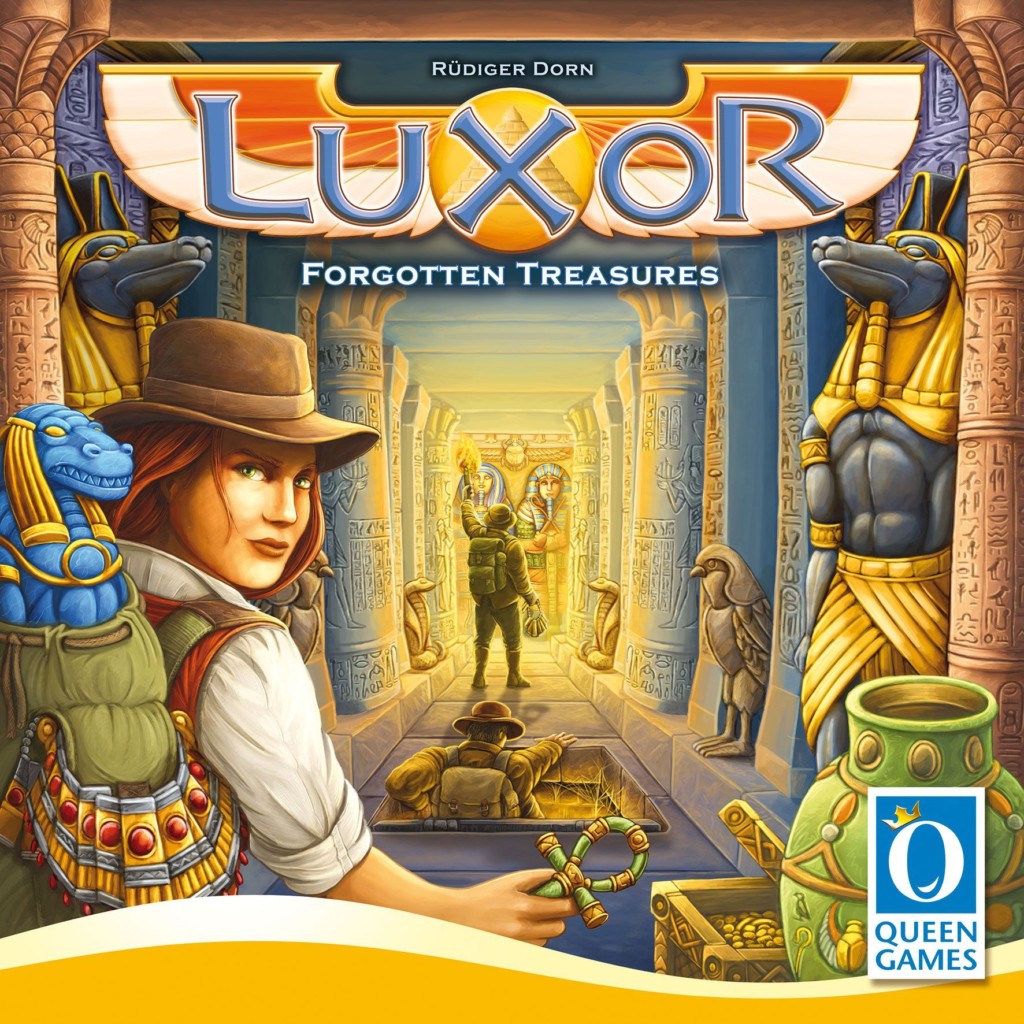Luxor is all about set collection while moving down into a winding Temple.
Will you control any of the two lucky Adventurers that make it to the middle?
On the hunt for priceless treasures, groups of adventurers explore the legendary temple at Luxor. Their ultimate goal is the tomb of the pharaoh, but many treasures can be collected as they search.
Luxor Game Play
I played an online version so all images are from that version, but you could probably tell from the pictures!
Let’s start with the board ’cause there are some bits we need to look at before moving on to gameplay.
There are Sarcophagi tokens in the central Tomb Chamber with some 5 and 3-point tokens. Everyone gets 5 adventurer meeples with 2 standing up on the start space of the board and the other 3 laying down on Anubis statue spaces scattered around the board.

On the board itself are Horus tiles in their yellow spaces and 4 random Osiris tiles in their spaces. Off to the side is another board with Horus and Treasure cards. I think that’s it…
Players get a hand of 5 basic cards, and this is very important, THE ORDER OF THESE CARDS CAN NOT BE CHANGED.

You can see some have numbers and some have a die symbol, there are others. We’ll get to those during gameplay which is… NOW!
Game Play
Players basically take turns playing a card, activating the card, moving an adventurer, activating the space and drawing a card.
I said you can’t rearrange the cards in your hand and here is why. You play a card, but only the cards in the left and right of your hand. The three cards in the middle are not available to you yet.
If the card has a number you move one of your available (stood up) adventurers that many spaces. If it has a die, you roll the D6 and move that many.
There are special Horus cards which have different movement abilities including a range of movement numbers, +/- 1 to a die roll, move all adventurers, move the furthest back etc
As you move around the board you skip empty tile spaces… But how and why are they empty I hear you ask? Well, this is where you activate the tile space you land on and you might be able to take it.

Activating Tiles
If you have enough of your meeples on a Treasure tile, you keep it. The number needed is shown on the tile and varies from one to three. Sometimes these spaces are left empty, other times the tiles are replaced with a tile from those stacks off the board. There are a few different types:
Temples – Take a Scarab (End game VPs)
Wild – Counts as any treasure for set collection purposes
Favour of Horus – Take a Horus card
Tunnel – Move to the next tunnel
Horus tile – Either a Key or an Eye Card
Osiris – Move your adventurer that many spaces and activate the new space
If you move by one of your laid-down adventurers, stand it up back on the start space of the board.
Then you draw a card which is slotted into the middle of the 4 cards in your hand.
Tomb Chamber
Adventurers can only enter the central Tomb Chamber if they move the exact number of spaces required and have a key card to discard.
The first adventurer will take the 5VP token and the second the 3VP token. The game ends at the end of the round (even turns) when 2 adventurers are in the central tomb.
Scoring
There are various ways points are scored so let’s go thorough them.
Around the Temple there are points on the wall, you score each of your upright adventurers for how far they are around the board. You get the 5 and 3 points if you made it to the central chamber of course.
Unused Keys are worth a VP. Use the Vase, Statue, Jewellery and Wild treasure tiles to make sets of 3 different icons. Score 3-52 points for having 1-8 sets.
Score VPS on scarab tiles and the most points wins!
Theme
Sure… I mean you can Horus it up all you want but it’s just a set collection game with Egyptian stuff.
If collecting sets of Egyptian treasure is your thing, you have about 100 games to pick from!
Artwork
Queen Games innit? They all look the same. This is a 2018 game that looks like it was made in 2008.

Ease of Teaching & Accessibility
I mean, it’s a family weight game so obviously teaching is fairly easy. But there are a lot of different things to track and restrictions which pushes it up to the higher end of that scale.
There are both Horus tiles and Horus cards which seems like an odd choice, that’s more-us Horus than required.
Luxor Summary
So I read about the ancient temples in Luxor after playing and they have a cool story, I like when a game makes me learn something 🙂
For similar games, I like Archaeology: The New Expedition as an Egyptian set collection game and Camel Up is a game set in Eqpt with a unique movement mechanism 🙂
I assume no one cheats with their cards right? We played the digital version so it wasn’t possible but people definitely could if they wanted.
But, this is essentially a really dull set collection game with a cool and unique hand-management mechanism. It feels like a game that should have had Days of Wonder develop and produce to make it.. you know… better?
Something as solid and pretty as Five Tribes for example? Otherwise, it’s just OK.
Jesta ThaRogue



Leave a Reply